Mastering Net Recurring Revenue: Key Insights for 2024
What is net recurring revenue? Is it important to SaaS businesses and what are some ways to improve it? Read on to learn all you need to know about this metric.

This post was last updated on March 07, 2023.
Jump to read
What Is Net Recurring Revenue?
Net Recurring Revenue vs. Gross Recurring Revenue
How to Compute Net Recurring Revenue?
What Is a Good Net Recurring Revenue Rate?
What Does SaaS Net Recurring Revenue Indicate?
Why Is Net Recurring Revenue Important?
How to Improve Net Recurring Revenue
FAQs
Start Paying Attention to Your Net Recurring Revenue
It’s easier to achieve real business growth when you’re not losing revenue along the way.
It gets even better when your existing customers increase their spending with you, especially for subscription-based SaaS companies.
This is why net recurring revenue takes center stage in determining the health of a SaaS business and its long-term viability. Net recurring revenue shows your company’s ability to survive on revenue coming solely from existing customers.
If your SaaS business can achieve a high net recurring revenue, a large number of new customer sign-ups will just be the cherry on top and further boost your bottom line.
You can have a top-tier product and an enviable growth trajectory. But if you can’t sustain customers and your business is heavily reliant on new accounts for revenue, your business’s future will remain uncertain.
And that’s not all. With a low net recurring revenue, convincing investors to provide you with funding will be hard and your business’s valuation will suffer.
What Is Net Recurring Revenue?
Net recurring revenue (NRR) is one of the most critical key performance indicators (KPIs) needed to measure the performance of your SaaS business.
It’s the revenue from existing customers that you’re earning over a given period. A higher NRR means that your existing customers are spending more on your brand.
Net recurring revenue indicates how much revenue is expected to continue in the future. It’s a good indicator of your customer retention. Higher NRR effectively means that more customers are sticking to your brand. This is revenue that’s predictable, regular, and to a high degree—certain.
Unlike monthly recurring revenue (MRR) which only pays attention to the number of monthly customers and the average revenue per account, net recurring revenue pays attention to revenue expansion, revenue contraction, and revenue churn. This makes it a very valuable indicator of your business growth.
New customers do not have a direct impact on net recurring revenue.
Net Recurring Revenue vs. Gross Recurring Revenue
While net recurring revenue (NRR) is a key metric for SaaS businesses, it’s often confused with gross recurring revenue (GRR). Understanding the difference is crucial in accurately assessing your company’s financial health and customer loyalty.
Net recurring revenue shows how much revenue is retained and expanded from your existing customer base. In contrast, gross revenue retention (GRR) gives a more focused view of customer retention without factoring in upsells, cross-sells, or customer churn.
In simple terms, gross revenue retention only considers the revenue generated from existing customers, excluding any revenue growth from expansion or new customers.
The gross revenue retention formula is:
GRR = [(Total revenue from retained customers at the start of the period – Revenue lost during the period) / Total revenue at the start of the period] x 100
Here are some key differences between GRR and NRR:
- GRR measures customer loyalty and product engagement without considering upsells or additional services.
- NRR factors in retention, revenue contraction, revenue churn, and expansion.
- NRR includes revenue metrics tied to upsells and cross-sells, providing a fuller picture of growth within the existing customer base.
- While GRR caps at 100%, NRR can exceed 100%, indicating growth from existing customers.
- GRR showcases your ability to keep customers, while net dollar retention (NRR) demonstrates your capacity to generate more value from them over time.
- A business with a high GRR but low NRR may excel at retaining customers but struggle to increase revenue from its existing customer base.
By understanding both metrics, you can gain valuable insights into your customer retention strategies and revenue growth potential.
While GRR helps you assess the stability of your customer base, NRR provides a clearer picture of your business’s ability to grow through existing customers. This makes it an essential metric for SaaS companies focused on sustainable growth.
How to Compute Net Recurring Revenue?
The formula for calculating your net recurring revenue is pretty straightforward. You need to take your monthly recurring revenue and remove the lost revenues and add the additional revenues.

Where:
- Monthly recurring revenue is the recurring revenue at the start of the month.
- Revenue expansion includes total revenue gained during the month from upgrades, cross-sells, add-ons, or any action that leads to account expansion.
- Revenue contraction includes total revenue lost during the month from downgrades, or any action or inaction that reduces the amount of revenue coming in from a customer.
- Revenue lost is churn. It represents customers who stop doing business with your company due to cancellations or contract expirations.
Along with net recurring revenue, it’s also important to calculate the net revenue retention rate. It helps you figure out how much percentage of your net revenue is being retained over time.

What Is a Good Net Recurring Revenue Rate?
A good net recurring revenue is when your net revenue retention rate exceeds 100%. This essentially would mean that the revenue you’re retaining is growing over time.
The higher, the better.
Net revenue retention below 100% means the revenue retained is low. It means you should investigate why your customers are not satisfied with the value they’re getting from your SaaS business.
What Does SaaS Net Recurring Revenue Indicate?
A high net recurring revenue indicates a high growth potential and a stable customer base.
It shows that your SaaS company will keep growing even if you don’t get new customers.
A high net recurring revenue also means that your revenue expansion is more than contraction.
This means you’re excelling in getting repeat subscriptions, upsells, cross-sells, add-ons, and other forms of expansions. And your existing customer base is happy with the value your business is providing.
A low net recurring revenue, on the other hand, is an indication that your SaaS business is depending on new subscriptions to make up for the revenue churn.
Why Is Net Recurring Revenue Important?
Computing your net recurring revenue will have three main benefits.
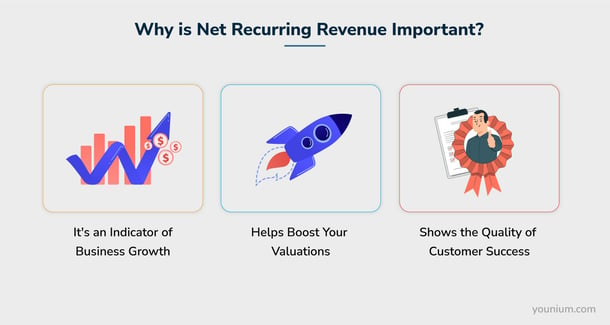
1. Serves as an Indicator of Business Growth
Net recurring revenue seeks to measure how sustainable the business revenue growth of your SaaS business is.
Rather than looking at ‘growth’ in general, it focuses on growth that can be upheld into the future due to a high customer retention rate.
Keeping track of your net recurring revenue helps you focus on retaining your existing customers and growing their accounts.
You’re able to identify shortcomings in your product value proposition and pricing as well. This is because lower recurring revenue is an indicator of high customer churn.
2. Helps Boost Your Business Valuations
Investors are careful to commit their money only to businesses that have a strong future.
Net recurring revenue is one of the most important subscription business metrics that gives investors a realistic picture of how much growth your SaaS business can achieve from its existing customers.
When you have a high net revenue retention rate, it shows your business is in good health and viable over the long term.
A low net revenue retention rate indicates your business is facing serious challenges that could hinder it from growing successfully. This can put potential investors off.
3. Shows the Quality of Customer Success
Customer success involves anticipating customer challenges and proactively providing solutions.
It is critical in helping your customers achieve the benefits you promised, which, in turn, helps your SaaS company realize its business objectives.
Customer success increases your customer retention, leading to increased net recurring revenue.
A high net recurring revenue is an indication that your customer success strategy is having a positive impact.
How to Improve Net Recurring Revenue
As mentioned earlier, a higher net revenue retention rate is an indication of an improvement in your net recurring revenue.
Here are some measures you can put in place to improve this key SaaS metric.
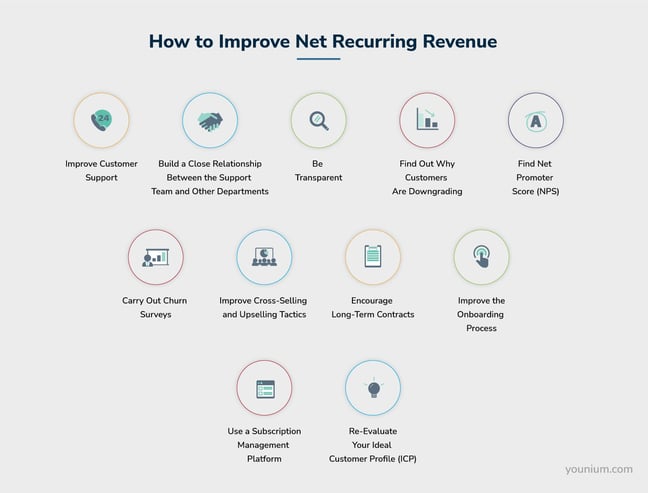
1. Improve Customer Support
For SaaS businesses, customer service is critical for retaining customers. Poor customer support results in cancellations and revenue churn, which causes a low net recurring revenue.
Knowledge gaps, for instance, can confuse your customers when it comes to using your product.
You can create a positive customer experience by creating a searchable knowledge base.
This is a place where customers can find quick answers to their problems. Additionally, you can provide a helpful customer service team to help them out with tougher problems.
Creating the knowledge base will also reduce the number of incoming tickets your team encounters. A lower workload can help the customer support team give more attention to complicated issues and still provide a great experience to your customers.
It’s also important to have multiple customer support channels. Make these support channels easy to find to reduce customer churn.
Your ‘Contact Us’ button, live chat boxes, chatbots, links to documentation, and other support features should be prominently visible on your website.
Here is an illustration of how Snowflake does it. They’ve provided plenty of resources to help customers solve their problems without having to contact the customer service team.
And the ‘Contact Us’ button is unmistakable at the top and bottom of the web page.
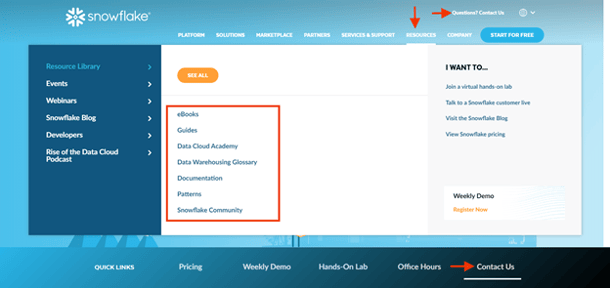
Image via Snowflake
2. Build a Close Relationship Between the Support Team and Other Departments
Your support team has interacted the most with your customers.
They talk to your customers directly and know what they love about your services and what they struggle with.
As a result, they can identify features that’d help you provide more value to your customers, increasing your chances of retaining them and boosting your net recurring revenue.
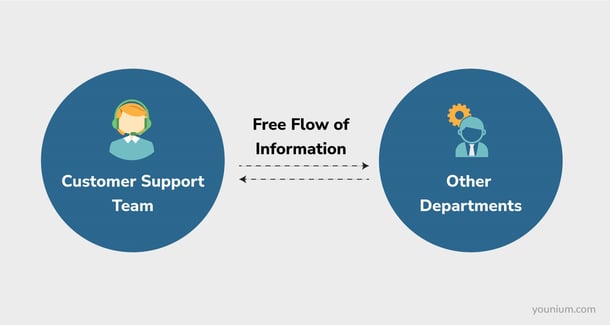
It’s due to this reason that you should build a strong connection between your support team and the SaaS product team. You can directly incorporate their feedback and improve your product.
It can help create a positive experience and improve the customer journey, boosting your net revenue retention rate.
In addition, the support team can identify customers who need additional products or features to make their experience better. Communicating such information to the marketing and sales team gives them a better idea of how to upsell or cross-sell to the customer.
3. Be Transparent
People might associate a subscription-based SaaS business with hidden costs. They may also wonder if the platform will have a solid uptime or not.
So when a problem like downtime happens, these customers may become infuriated and this will give rise to unhappy customers. This can reduce your net recurring revenue.
The best approach in dealing with such skeptical customers to reduce your churn rate and improve your NRR is to remain transparent — about everything.
Be straightforward about all your costs.
If you introduce changes to your contract during renewal, create space for renegotiations and be straightforward about them.
When you experience system glitches, inform your customers right away and work to resolve the problem quickly. Additionally, if you anticipate downtime in your software, email your clients in advance.
Doing this removes the element of surprise that your customers may get if your platform suddenly goes down. Similarly, keeping space open for negotiations means your customers will feel heard.
4. Find Out Why Customers Are Downgrading
Sometimes, a customer may not downgrade due to a negative customer experience or dissatisfaction with your SaaS product.
Mistakes by the customer can cause them to downgrade, such as paying for the wrong subscription or tier, upgrading by mistake, or upgrading at the wrong time.
But even in such cases, the customer downgrades affect your net recurring revenue.
Do research into why customers are downgrading and find any underlying issues that you can resolve.
For instance, you can take measures like:
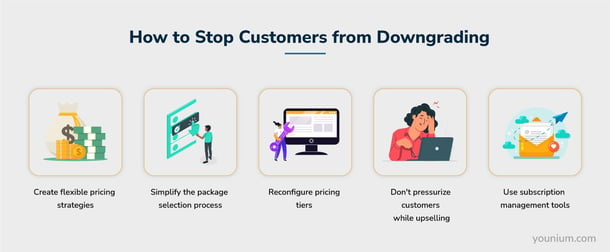
- Creating a more flexible pricing strategy. It allows customers to pick a package that works for their budget, reducing revenue churn due to the inability to pay.
- Making it easier for customers to choose a package that’s right for them, such as providing more details for each subscription package.
- Reconfiguring your subscription tiers to better target different audiences. Create multiple contract types designed for customers with limited funds, audiences willing to experiment, those with large budgets, and startups.
- Giving customers more time to understand your software before pursuing account expansion through an upsell or cross-sell. Pressurizing a customer to upgrade or buy a product only causes them to downgrade later when they realize they don’t need it.
- Using a subscription management tool to prevent confusion in managing the customers’ subscription lifecycles. You’re able to answer your customers’ questions about their accounts accurately and with minimal delay when you have all the data with you. In fact, a subscription management solution can handle pretty much everything mentioned in the bullets above, making it a great tool to reduce downgrades.
Ensuring that your customers get a product fit for them leads to customer satisfaction and increases your net revenue retention.
5. Find Net Promoter Score (NPS)
Using in-app NPS surveys can give you information on how satisfied a customer is with your product and whether they’re likely to stick around for the long term.
An NPS survey is a single-question survey that measures your customer experience using a rating.
For instance, the survey question can be “How likely is it that you’d recommend our product to a friend?”.
By setting the right questions on the NPS survey, you can get reliable information on customer pain points and correct them before they can churn. This keeps your net recurring revenue at an optimal level.
6. Carry Out Churn Surveys
Use churn surveys to reach out to customers who have started a subscription cancellation or have already canceled their subscription. Doing so could potentially convince them to return and improve your net recurring revenue.
You can ask questions, such as:
- What’s the reason they’re leaving or unwilling to renew their subscription?
- Is there anything that you can do to make them stick around?
- What can you do to make them subscribe to your product again?
Even though the customer may still cancel the subscription, you’ll have obtained valuable information. Use this information to improve your services and prevent a high churn rate, keeping your net recurring revenue high.
7. Improve Your Cross-Selling and Upselling Tactics
Getting more revenue from existing customers is one of the factors that contribute to a healthy net revenue retention rate.
This is where cross-selling and upselling become important.
You can become more successful in your upselling and cross-selling efforts by first analyzing which value metrics are most important to your existing customer base.
Then, use this knowledge to employ marketing tactics that encourage your customers to expand their spending, which increases your subscription revenue.
For instance, you can send emails that remind customers of what your software has helped them achieve and show them the value they’re missing out on by not upgrading.
Use modals or in-app contextual messages.
They can be effective in encouraging the customer to upgrade right when they need the feature that’s currently inaccessible in their package.
But be careful not to be too pushy when trying to get a customer to pay for a more expensive subscription tier. It could cause them to cancel or downgrade their subscription if they don’t see value in it.
Keep in mind that the most important thing is to provide value to the customers when they upgrade.
It’s only then that they’ll be more likely to upgrade further, add more seats, buy an integration, or spend more on other products offered by you. All these can improve your net recurring revenue in the long run.
But what do you do when your customers hit the ceiling for their current pricing plans? While they would be required to upgrade their plan and pay a higher fee, you could make this process smoother too.
And that’s where your messaging tone becomes important. When you’re notifying your customers about the need for an upgrade, you should use a positive tone.
Take a cue from HubSpot. Note how they’ve mentioned that they’re happy to see their customers’ business grow in the subject line. And then in the email they’ve explained how that also means that they’ve been upgraded to the next tier.
So, while the customer will end up having to pay more for their service, they wouldn’t mind it as the experience of getting upgraded to the next tier is a positive one.
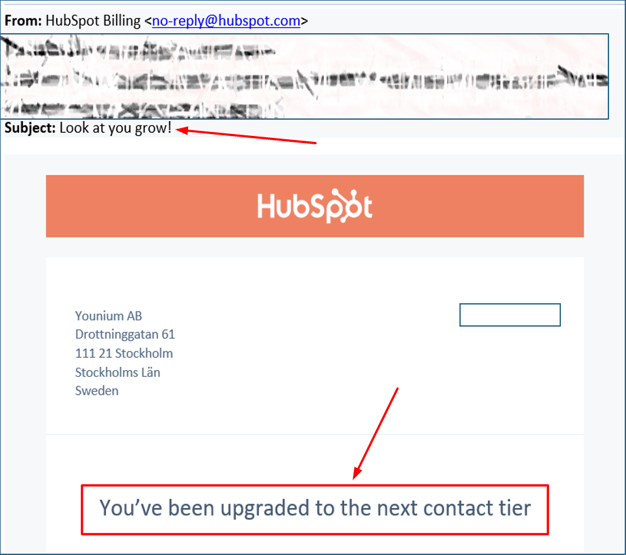
8. Encourage Long-Term Contracts
Most businesses in the SaaS industry provide monthly or yearly subscription packages.
There is nothing wrong with a customer buying a monthly subscription.
But it’s better for your net recurring revenue when customers commit to longer subscriptions like quarterly, half-yearly, or annual basis.
The longer they use your service before the contract expires, the better chance they’ll have of experiencing its benefits. They’ll have enough time to see how much value it can add to their business.
Once they experience these benefits, they’re likely to stick around longer, leading to higher net recurring revenue.
Additionally, it assures you of consistent revenue during that period.
You should consider offering a discounted price for long-term contracts to make them attractive to the customers. The longer it is, the higher the discount should be. Yearly contracts, for instance, should have a higher discount than quarterly contracts.
Here is an example of Slack’s pricing system.

Image via Slack
The charge per person, per month, for the Pro plan, when billed annually is $6.67/month. But the price increases to $8/month for customers who choose monthly billing.
9. Improve the Onboarding Process
New signups don’t affect the net recurring revenue. But optimizing the onboarding process of new customers can cause them to stay with your business for longer, which can boost your NRR.
A smooth onboarding process creates the perfect opportunity to show your product’s value proposition. You can use it to prove to your customers all the ways your product can be of benefit to their business.
You can make the onboarding process personal by having a representative from your team guide the customers through the platform. If there’s a steeper learning curve, you can even set up tutoring sessions.
This makes the customer have a positive experience from the get-go and increases your net recurring revenue by reducing churn.
10. Use a Subscription Management Platform
When you’ve got a subscription-based business model, getting a subscription management platform is a no-brainer.
With a platform like Younium, you can effectively manage the entire B2B customer lifecycle. It provides team collaboration features that can help ensure seamless communication between departments.
Additionally, a subscription management platform can help you track the customer spend along with the categories of their spending too.
But the most important aspect of these platforms is the data they provide.
You get access to detailed analytics about your business when you use a platform like Younium. All your business metrics will be visible at a glance, including net recurring revenue. This removes the need to calculate them from scratch as well.
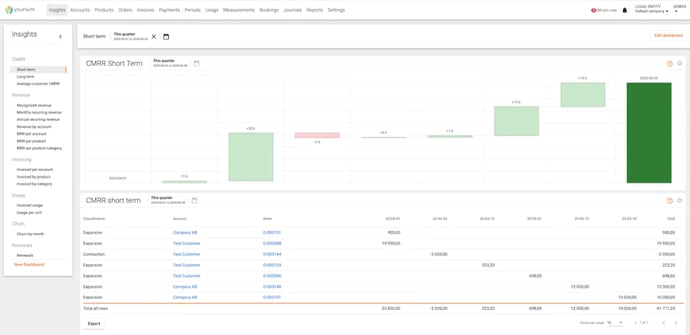
Based on these analytics, you can figure out if your net recurring revenue is growing over time or not and take corrective measures accordingly.
Finally, the APIs offered by these platforms can help you connect your platform with others like CRMs and customer success platforms. This can help you further improve your services, aiding customer retention.
11. Re-Evaluate Your Ideal Customer Profile (ICP)
A low net recurring revenue could indicate that you need to redefine your ICP.
You could be targeting the wrong customers, and it could be the reason they’re not sticking around.
How do you solve this issue?
Start by re-creating a detailed description of the type of customer who’ll benefit from your products.
What are their pain points, their needs, and the tasks they struggle with?
Use these details to come up with your ICP and then incorporate this into your marketing strategy.
Keep in mind that just as your SaaS business is constantly growing, your ideal customer profile will evolve as well.
Revisit this bio regularly and adjust it to reflect:
- Shifts in your audience
- Changes in your products and pricing
- External factors that may affect your ICP
FAQs
1. How is net recurring revenue calculated?Net recurring revenue is a key metric calculated by computing the sum of the monthly recurring revenue at the beginning with the growth in revenue and the loss in revenues.
NRR = Total monthly recurring revenue + revenue expansion - revenue contraction - revenue lost
2. What is Net Revenue Retention (NRR) in SaaS?Net Revenue Retention is a metric that SaaS companies can use to determine the amount of total revenue retained from existing customers over a given period.
It incorporates customer upgrades, upsells, cross-sells, downgrades, and churn.
3. What is NRR vs ARR?Average recurring revenue (ARR) is the amount of revenue your SaaS business receives that’s expected to continue.
Net revenue retention (NRR), on the other hand, is the amount of recurring revenue you’ve retained during a given period.
4. What is net dollar retention (NDR)?Net dollar retention (NDR) is just another word for net revenue retention. It’s an indicator of how much your annual recurring revenue or monthly recurring revenue has grown or shrunk within a given period.
5. Why is NRR important?Measuring net revenue retention provides a better picture of the sustainable growth of your SaaS business than other metrics. It shows if you can sustain the current growth of your business even if you aren’t acquiring loads of new customers.
High net revenue retention (NRR) gives investors the confidence that your business has a strong future. Net revenue retention that’s above 100% also shows that your customer success strategies are paying off.
Start Paying Attention to Your Net Recurring Revenue
Net recurring revenue is not just another metric. It’s a key indicator of the long-term growth potential of your business and you want it to be as high as possible.
Additionally, the net recurring revenue should help keep your net revenue retention above 100%.
For this, it’s essential to improve your service, build a rich knowledge base, and encourage customers to stick around for the long term.
A subscription management platform can help you with it all by arming you with the data you need to get your customers to stick with you. So, get your free demo of Younium now to understand how it can help improve your net recurring revenue.